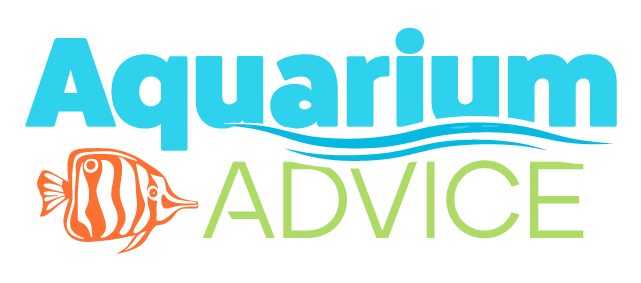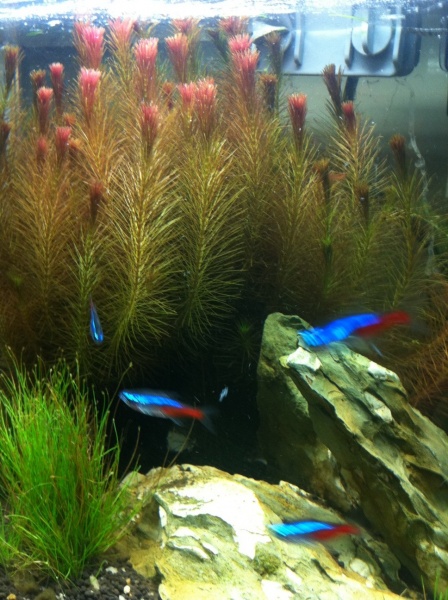
Adding fertilizer in a planted tank can be a confusing and daunting prospect. There are a lot of products out there for purchase, and not much information about what is actually needed for success.
There are a few things to consider when deciding what fertilization your tank may need, if any. For plants to grow, the primary consideration has to be lighting. The amount of light is usually the first thing to consider when deciding on what kinds and how much fertilizer to add. The higher the light, the faster photosynthesis will occur, which means plants will uptake more nutrients. Low light tanks can often survive with very little fertilizer supplementation other than the nutrients that are introduced via fish food and fish waste.
The next basic nutrient requirement is Carbon Dioxide, or CO2. Again, the amount of CO2 that is used by your aquatic plants will depend greatly on the intensity and amount of lighting you provide. Essentially, low light tanks and most medium light tanks can get away without CO2 injection, as aquarium water will remain at equilibrium with the air, roughly 7ppm CO2. As you move into higher light, plants will uptake CO2 faster than it can be replenished naturally through diffusion with air, and CO2 injection will become necessary to maintain a balance. For more on CO2, see this article: http://www.aquariumadvice.com/beginners-guide-to-co2-injection-in-the-planted-tank/
As with CO2, adding additional nutrients in the form of fertilizers is also directly related to how much light you are providing your plants. The higher the light, the more fertilizer will be required, and the greater the diversity of fertilizer you must provide.
We generally divide supplements into 2 main categories: Micronutrients or trace elements, and Macronutrients. I will give a brief overview of both:
MACRO NUTRIENTS (OR NPK)
Nitrogen (N)
Nitrogen is generally supplied in the planted tank through ammonia, nitrite, and nitrate, which are compounds found in all tanks with fish. It is generally one of the first nutrients to require supplementation in the planted tank. It can be provided using liquid fertilizers commercially available, such as Seachem Nitrogen, or can be added using a dry powder form, via adding the compound Potassium Nitrate (KNO3).
It is generally recommended that to provide enough Nitrogen for uptake by your plants, you want to keep your nitrate levels in your tank at 10-20ppm. Nitrogen deficiency in your plants will generally manifest itself as small yellowing or lighter colored leaves in new growth.
Phosphorus (P)
Phosphorus is a macronutrient required for plant growth and health. It is generally used by plants in the form of Phosphate (PO4). Because of the harmful nature of PO4 to other aquatic life in your tank, we generally try to keep the levels very low. It is generally one of the last nutrients needed for supplementation because we can get by with very low levels, and PO4 is found in many of the foods we feed our fish, and the left over is more than enough to supplement our plants.
It is generally added to the tank in the form of a liquid fertilizer such as Seachem Phosphorus or as a powder form as Monopotassium Phosphate or KH2PO4. We generally want to keep our tanks at 1.0-2.0ppm PO4, though I have had success in keeping lower levels of around 0.5ppm, especially in tanks with sensitive inverts.
Phosphorus deficiencies manifest themselves as yellowing leaves in established growth, and can look very similar to nitrogen deficiency.
I would not recommend dosing P in medium light or low light systems. It can easily cause algae problems, problems with fish and invert health, and is just generally not required in lower light setups. However, in high light setups, you will find yourself quickly bottoming out on P and causing nutrient deficiencies and algae problems if you do not dose it.
Potassium (K)
Potassium is the 3rd and final macronutrient. It is a fairly benevolent nutrient when it comes to aquatic life, so there is not much harm in liberally dosing it. It along with N are often the first nutrients I would recommend dosing in low and medium light tanks. It is generally accepted that the desirable potassium (K) levels in a planted tank are 10-20ppm, but it can be dosed up much higher than that without issues. You can find titration tests for testing Potassium levels, but because it is not harmful in moderate amounts, it is easier to just dose more than enough to make sure you are covered. It can be dosed using a commercial liquid product such as Seachem Potassium, or can be added as a dry powder in the form of Potassium Sulfate, or K2SO4.
Potassium deficiencies manifest as yellowing leaf edges or small pin holes in leaves, especially in established growth.
MICRO NUTRIENTS OR TRACE ELEMENTS
There are also several other organic and inorganic compounds and elements that are required by plants to remain healthy and grow, but are needed in far less concentration. We generally refer to these as trace elements. There are several elements and compounds on this list, including magnesium, chelated copper, chelated iron, manganese, molybdenum, zinc, cobalt, and a few others.
They can be dosed using a liquid trace mix such as Seachem Trace, or can be dosed as a dry powder using a product such as Plantex CSM+Boron. Often people will chose to dose Chelated Iron separately from other trace elements, though most commercial trace mixes do include some level of Chelated Iron.
WHAT TO BUY?
It really depends. There are so many forms of supplementation for the planted tank. You can buy nutrient rich planted tank substrate such as aquasoil or ecocomplete. You can buy root tabs for heavy root feeder plants… root tabs usually provide trace elements and 1 or more macronutrients. You can buy liquid mixes such as Seachem Flourish, which is a source of Potassium and Trace elements, with a small amount of Nitrogen supplementation, or API Leafzone & Tetra Florapride, which are primarily trace and potassium mixes. You can buy individual liquid supplements such as the seachem line as I outlined above, or you can buy dry powders of each.
What I would recommend depends greatly on the types of plants you are growing, the lighting, the CO2 levels, and the deficiencies that your plants may or may not be exhibiting.
As a general guideline though, my recommendations usually go something like this:
1. A liquid mix like Seachem Flourish, or API leafzone for low light tanks and beginners who are looking for some supplementation. These products generally won’t cause too many issues if dosed as the directions state.
2. Individual liquid doses for macros and micros for medium light tanks and those still newer to planted tank supplementation and planted tanks in general. The seachem line of individual solutions of N, P, K, Trace, and Iron are a great place to start. Pfertz also makes some very good individual dosing solutions.
3. Individual dry powder doses of N, P, K, and Trace for high light tanks and for those more experienced. This is the best way to dose as far as economics, as dry powder is far cheaper in the long run than liquid ferts… with liquid ferts you are paying mostly for water. It also offers a lot more flexibility in controlling individual nutrient levels to hit specific targets, as opposed to using mixed solutions of liquid ferts.
DOSING METHODS
While I intend this to be just an intro, and deep discussions of individual dosing methods are beyond the scope of this article, I will mention a few of the more common methods. Google can be your friend here to help you determine which dosing method is right for you.
Estimative Index (EI) Dosing
EI dosing became very popular a few years back and is a very easy method. Essentially it involves dosing each individual macro and a trace mix up to a high level during a weekly water change. At the end of the week, a 50% water change is performed, cutting the remaining nutrients in half, and the tank is dosed again. This is a simple way to insure you never bottom out on any nutrients.
Target Dosing
Target dosing involves performing water tests on Nitrate, Potassium, Phosphate, and Iron levels and dosing according to the target levels for your tank.
PPS Pro Dosing
PPS Pro dosing has become very popular in the last few years. It involves dosing the tank with the amount of each nutrient needed during a 24 hour cycle. It requires daily dosing, but is great for keeping the tank from having excess nutrients which can cause algae issues. It does involve some math and some pretty small measurements, but is a very effective way to dose. There are some great build threads out there on making autodosers for pretty cheap that work well for this method. That way the daily dose is delivered automatically. Check them out:
http://www.aquariumadvice.com/forums/f20/diy-auto-doser-build-143431.html
http://www.aquariumadvice.com/forums/f20/diy-auto-dosing-solution-101464.html
Hopefully this article has given you some ideas on fertilizer supplementation in the planted tank. It can be a daunting task to determine exactly what you need, but there is no 1 stop solution for every tank out there. It involves some trial and error and a little experience, but once you find the best method and amounts for your tank, the difference in plant health and growth will be dramatic.

Happy Planting!
Element Images courtesy of periodictable.com.





